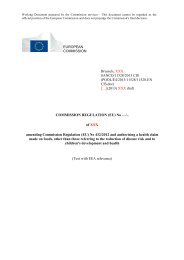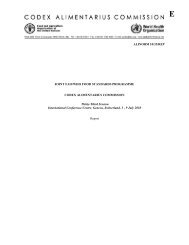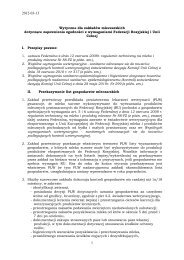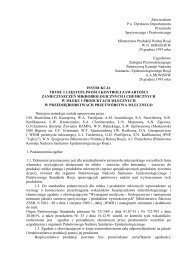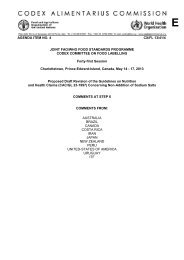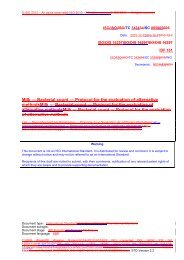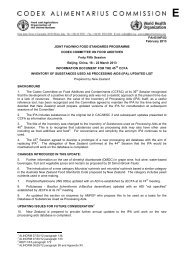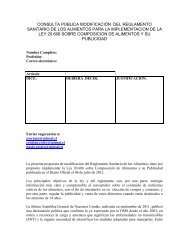ALINORM 03/32 - CODEX Alimentarius
ALINORM 03/32 - CODEX Alimentarius
ALINORM 03/32 - CODEX Alimentarius
Create successful ePaper yourself
Turn your PDF publications into a flip-book with our unique Google optimized e-Paper software.
REP 13/FA 8<br />
work was not intended to provide support to CCFA on work on the GSFA as JECFA was the international<br />
expert scientific advisory body to provide such advice to the Committee.<br />
59. The Committee, however, considered that there was a merit in the proposal and, therefore, agreed to<br />
slightly amend the scope to indicate that the Guidelines could also be used as a screening tool by national<br />
governments to support their work on the GSFA.<br />
Main aspects to be covered<br />
60. Following the discussion on the scope, the Committee did not agree to include a reference to other<br />
appropriate screening methods reflecting the data available in the first bullet as this might lead to the<br />
application of methodologies of different levels of complexity. It further noted that the theoretical maximum<br />
daily intake (TMDI) and estimated daily intake (EDI) were simple and conservative approaches to ensure<br />
protection of consumers’ health, that the GSFA already contained guidance to screen proposals for<br />
development of maximum levels for use of food additive with numerical acceptable daily intakes i.e. the<br />
Budget method.<br />
61. Along the same lines, the Committee did not agree to include a reference to modelling of high<br />
consumers in the third bullet as, although modelling tools to characterize risk on sensible population groups<br />
were in the remit of risk assessment, the decision to modelling for sensitive groups laid with risk managers<br />
and the revised guidelines were not intended to modelling data to estimate food additive intakes of special<br />
group populations. In this regard some modelling guidance that governments could apply in this particular<br />
situation were already made available within the FAO/WHO document EHC-240.<br />
62. In reply to a comment that intake assessment to food additives should not apply to fresh produce in<br />
general, the Committee noted that the intake assessment primarily applied to processed foods.<br />
Conclusion<br />
63. The Committee agreed to start new work on the revision of the Guidelines for the Simple Evaluation of<br />
Food Additive Intakes (CAC/GL 3-1989) and to forward the project document as revised to the 36 th Session<br />
of the Commission for approval as new work (Appendix V).<br />
64. The Committee further agreed to establish an electronic Working Group, led by Brazil, open to all<br />
members and observers and working in English only, to prepare proposed draft revised Guidelines for<br />
circulation for comments at Step 3 and consideration at its next Session, subject to approval of new work by<br />
the 36 th Session of the Commission.<br />
GENERAL STANDARD FOR FOOD ADDITIVES (Agenda Item 5) 11<br />
65. The Delegation of the United States of America, as Chair, introduced the report of the pre-session<br />
Working Group on the GSFA.<br />
66. The Working Group had made recommendations on:<br />
- Provisions in Table 1 and 2 of the GSFA for food additives listed in Table 3 with “acidity regulator”<br />
function and the horizontal approach and provisions in Table 1 and 2 of the GSFA for food<br />
additives listed in Table 3 with “emulsifier, stabilizer and thickener” function (Agenda Item 5a); and<br />
- Provisions for aluminium-containing food additives of the GSFA (Agenda Item 5b).<br />
67. The Working Group made recommendations for approximately 600 provisions of the GSFA. However,<br />
due to time constraints, the Working Group could not complete its agenda, which also included: (i) new<br />
proposals for the use of nisin (Agenda Item 5d); (ii) proposals for new additive provisions in food category<br />
16.0 “Prepared foods” (Agenda Item 5e); (iii) proposals for new additive provisions and/or revision of food<br />
additive provisions of the GSFA (Agenda Item 5f); and on a compilation of provisions for acesulfame<br />
potassium (INS 950), aspartame (INS 951) and aspartame-acesulfame salt (INS 962), related to Agenda<br />
Item 5c, 5f and 5g.<br />
68. The Committee considered the recommendations 1-12 of the Working Group and made decisions and<br />
commented as follows.<br />
11 CRD 2 (Report of physical Working Group on the GSFA); CRD 6 (Comments of China, India, Japan, Mali, Philippines,<br />
African Union and OIV); CRD 12 (Comments of Ghana, Indonesia, Malaysia and NHF)



